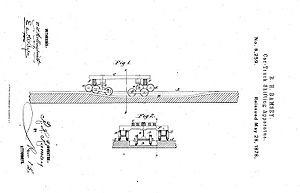
Ramsey Car Transfer Apparatus
Encyclopedia

Bogie exchange
Bogie exchange is a system for operating railway wagons on two or more gauges to overcome difference in the track gauge. To perform a bogie exchange, a car is converted from one gauge to another by removing the chassis containing the wheels and axles of the car, and installing a new chassis with...
bogie
Bogie
A bogie is a wheeled wagon or trolley. In mechanics terms, a bogie is a chassis or framework carrying wheels, attached to a vehicle. It can be fixed in place, as on a cargo truck, mounted on a swivel, as on a railway carriage/car or locomotive, or sprung as in the suspension of a caterpillar...
s on railroad car
Railroad car
A railroad car or railway vehicle , also known as a bogie in Indian English, is a vehicle on a rail transport system that is used for the carrying of cargo or passengers. Cars can be coupled together into a train and hauled by one or more locomotives...
s to permit transfer of a train between railroad lines
Gauge conversion
In rail transport, gauge conversion is the process of converting a railway from one rail gauge to another, through the alteration of the railway tracks...
with different gauge
Rail gauge
Track gauge or rail gauge is the distance between the inner sides of the heads of the two load bearing rails that make up a single railway line. Sixty percent of the world's railways use a standard gauge of . Wider gauges are called broad gauge; smaller gauges, narrow gauge. Break-of-gauge refers...
.
The Ramsey Transfer existed in a number of variations covered by several different patents. It was typically used to transfer cars between (standard gauge
Standard gauge
The standard gauge is a widely-used track gauge . Approximately 60% of the world's existing railway lines are built to this gauge...
) and narrow gauge (usually in width) track
Rail tracks
The track on a railway or railroad, also known as the permanent way, is the structure consisting of the rails, fasteners, sleepers and ballast , plus the underlying subgrade...
.
Two parallel tracks of were set approximately 9 feet (2.7 m) apart. Between these two tracks, the standard and narrow gauge tracks descended into a pit, one from each end of the pit, overlapping in the center and having a common center line. Beams resting on trucks riding on the 18 inches (457 mm) gauge tracks were inserted under the car to have its trucks changed. The car was then pushed over pit, resting on the beams. This allowed the old trucks to slip off the center pins. The old trucks were pulled out of the pit and new trucks were pushed in from the opposite side. As the car passed over the opposite side of the pit, the new trucks were guided to fit on the center pins. The car now continued on its way, its load undisturbed.
It was claimed that the entire procedure could be performed in less than eight minutes. However in 1851, this would have referred to wagons without continuous brakes. More time would have been taken to deal with post 1880 wagons with continuous brakes.
The Ligonier Valley Railroad
Ligonier Valley Railroad
The Ligonier Valley Railroad connected the communities of Latrobe and Ligonier, Pennsylvania, approximately apart, between 1877 and 1952. For much of its length, the railroad ran parallel to Loyalhanna Creek in a scenic mountain gorge...
was the first to utilize the method in 1878 in Latrobe, Pennsylvania
Latrobe, Pennsylvania
Latrobe is a city in Westmoreland County, Pennsylvania in the United States, approximately southeast of Pittsburgh.The city population was 7,634 as of the 2000 census . It is located near the Pennsylvania's scenic Chestnut Ridge. Latrobe was incorporated as a borough in 1854, and as a city in 1999...
. It was also used in the same year by the Rochester and State Line Railroad
Rochester and State Line Railroad
The Rochester and State Line Railroad typifies those transportation companies of the 19th century which arose from more than the customary desire to amass great amounts of money...
at its Salamanca junction with the Atlantic and Great Western Railroad
Atlantic and Great Western Railroad
The Atlantic and Great Western Railroad began as three separate railroads: the Erie and New York City Railroad based in Jamestown, New York; the Meadville Railroad based in Meadville, Pennsylvania ; and the Franklin and Warren Railroad based in Franklin Mills, Ohio...
, a six-foot gauge line.
See also
- Bogie exchangeBogie exchangeBogie exchange is a system for operating railway wagons on two or more gauges to overcome difference in the track gauge. To perform a bogie exchange, a car is converted from one gauge to another by removing the chassis containing the wheels and axles of the car, and installing a new chassis with...
- Gauge conversionGauge conversionIn rail transport, gauge conversion is the process of converting a railway from one rail gauge to another, through the alteration of the railway tracks...
- Variable gauge axlesVariable gauge axlesA variable gauge system allows railway vehicles in a train to travel across a break of gauge caused by two railway networks with differing track gauges....
- WheelsetWheelset (railroad)A wheelset is the wheel-axle assembly of a railroad car. The frame assembly beneath each end of a car, railcar or locomotive that holds the wheelsets is called the bogie...

